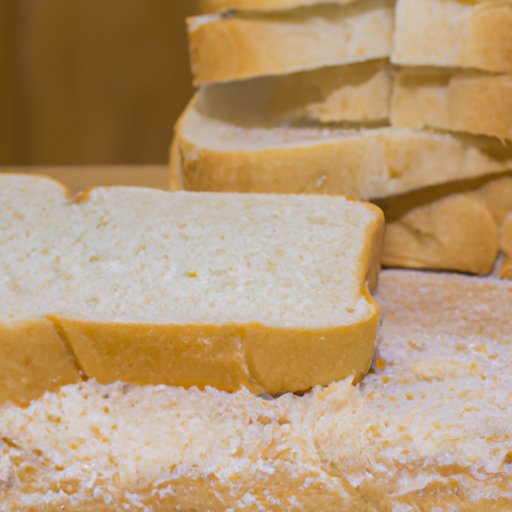Introduction
Wheat bread is a type of bread made from flour that primarily consists of wheat grains. It is one of the most popular types of bread consumed around the world and has become a staple in many diets. But is wheat bread actually healthy? This article explores the nutritional value and potential benefits of wheat bread, as well as common myths and misconceptions.

Examining the Health Benefits of Wheat Bread
Wheat bread is a good source of several essential nutrients, including protein, fiber, vitamins, and minerals. It also contains complex carbohydrates, which provide energy and help keep you feeling full longer. Additionally, wheat bread is low in fat and cholesterol-free. All of these factors make it an ideal choice for those looking to maintain a healthy diet.
In addition to its nutritional value, wheat bread may also offer some potential health benefits. Studies have suggested that consuming whole wheat bread may help lower your risk of certain chronic diseases, such as heart disease, diabetes, and obesity. Other research indicates that wheat bread may help reduce inflammation and improve digestive health.
Exploring the Scientific Evidence Behind Wheat Bread Nutrition
To better understand the potential health benefits of wheat bread, let’s take a closer look at the scientific evidence behind its nutrition. Several studies have examined the nutritional content of wheat bread and its effects on health.
One study published in the journal Nutrients found that whole wheat bread is a good source of dietary fiber, magnesium, phosphorus, folate, thiamin, and vitamin B6. The researchers noted that consuming whole wheat bread could help meet daily dietary needs for these important nutrients.
Another study, published in the journal Nutrition Reviews, looked at the potential health benefits of whole wheat bread. The researchers found that consuming whole wheat bread may help reduce your risk of coronary heart disease, diabetes, and obesity. They also noted that it may help improve digestion, reduce inflammation, and increase satiety.
Comparing and Contrasting Whole Wheat and White Bread
It’s important to note that there are two main types of wheat bread: whole wheat and white bread. While both types of bread contain wheat, they differ significantly in terms of their nutritional value. Whole wheat bread is generally more nutrient-dense than white bread, as it contains more fiber, vitamins, and minerals.
The role of whole wheat in a healthy diet cannot be understated. According to the Harvard T.H. Chan School of Public Health, whole wheat is a great source of essential vitamins, minerals, and fiber. Eating whole wheat bread instead of white bread can help you meet your daily dietary needs for these important nutrients.

Analyzing the Nutritional Value of Different Types of Wheat Bread
When selecting wheat bread, it’s important to consider the type of wheat used and the amount of added ingredients. Different types of wheat bread can vary greatly in terms of their nutritional value. For example, some types of wheat bread may contain added sugar, while others may not.
It’s also important to read the nutrition facts label when selecting wheat bread. This will give you a better understanding of the nutritional content of the bread, as well as any added ingredients. Pay particular attention to the sodium content, as some types of wheat bread can be high in sodium.

Investigating the Role of Wheat Bread in a Healthy Diet
When incorporating wheat bread into your diet, it’s important to do so in moderation. According to the U.S. Department of Agriculture (USDA), adults should aim to consume about 6 ounces of grains per day. Of these grains, at least half should come from whole grain sources, such as whole wheat bread.
In addition to limiting portion sizes, it’s important to choose wheat bread wisely. Look for varieties that are made with 100% whole wheat flour and don’t contain added sugar or other unhealthy ingredients. Also, opt for brands that are fortified with additional vitamins and minerals, such as iron, zinc, and folic acid.
Debunking Common Myths About Wheat Bread
Despite its potential health benefits, wheat bread is often the subject of various myths and misconceptions. One common myth is that wheat bread is less filling than other types of bread. However, research has shown that whole wheat bread can be just as filling as other types of bread.
Another myth is that wheat bread is higher in calories than other types of bread. In reality, wheat bread can be just as calorie-dense as other types of bread. It all depends on the type of wheat and the added ingredients used. Be sure to read the nutrition facts label to get a better understanding of the caloric content.
Conclusion
In conclusion, wheat bread can be a nutritious and satisfying addition to a balanced diet. It is a good source of essential nutrients and may offer potential health benefits, including improved digestion, reduced inflammation, and reduced risk of certain chronic diseases. When selecting wheat bread, it’s important to consider the type of wheat used and the amount of added ingredients. Additionally, it’s important to limit portion sizes and choose brands that are fortified with additional vitamins and minerals. By following these guidelines, you can ensure that wheat bread is a healthy part of your diet.
(Note: Is this article not meeting your expectations? Do you have knowledge or insights to share? Unlock new opportunities and expand your reach by joining our authors team. Click Registration to join us and share your expertise with our readers.)
